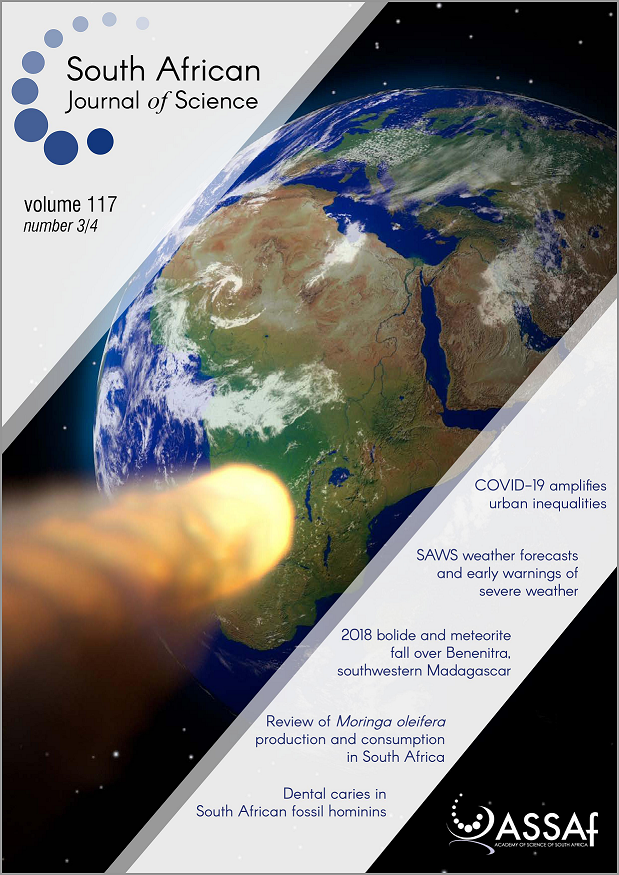An investigation of the 27 July 2018 bolide and meteorite fall over Benenitra, southwestern Madagascar
DOI:
https://doi.org/10.17159/sajs.2021/8200Keywords:
meteor fireball, chondrite, infrasound, cosmogenic radionuclide analysis, seismicAbstract
Several dozen stones of an ordinary chondrite meteorite fell in and around the town of Benenitra in southwestern Madagascar during the early evening of 27 July 2018, minutes after a widely observed meteor fireball (bolide) transit and detonation. The event was confirmed by low-frequency infrasound recordings received at ~17h15 UTC (Coordinated Universal Time; 19h15 local time) at the Comprehensive Nuclear Test Ban Treaty Organization (CTBTO) infrasound station I33MG near Antananarivo, 542 km north-northeast of Benenitra. An energy release equivalent to 2.038 kt of TNT was calculated from the infrasound signals. Seismograph readings at the SKRH station 77 km north-northwest of Benenitra recorded a twostage signal consistent with the arrivals of an initial air-coupled ground wave at 16h48:08 UTC and a stronger pulse at 16h49:22 UTC linked directly to the atmospheric pressure wave. The infrasound and seismic signal arrival times suggest that the bolide entry and detonation occurred at approximately 18h46 local time (16h46 UTC), entry was from the northwest, and the detonation hypocentre was located within ~20 km of Benenitra. Despite meteorite debris being found among buildings within Benenitra, there was no damage to structures or injuries reported. Eyewitness accounts and photographic records indicate that approximately 75 mostly intact stones were collected; however, the remoteness of the area, the rugged nature of the terrain and sales of fragments to meteorite collectors have limited scientific analysis of the fall and the extent of the strewn field. The total mass of recovered stones is estimated at between 20 kg and 30 kg, with one fragment of 11.2 kg and several of ~1 kg. Petrographic and mineral chemical analyses indicate that the stones belong to the L6 class of ordinary chondrites. Cosmogenic radionuclide analysis confirms that the fall is linked to the bolide event. The name Benenitra has been officially accepted by the Meteoritical Bulletin Database.
Significance:
- Eyewitness reports, CTBTO infrasound records, seismograph records and cosmogenic radionuclide analysis confirm a meteorite fall over Benenitra on 27 July 2018.
- Petrographic and geochemical analyses confirm that the meteorite is an L6 ordinary chondrite.
- Recovery of meteorite falls is rare; this is Madagascar’s second known meteorite fall and the first that can be linked to a bolide.
- Regional and global science monitoring networks can be interrogated to improve the understanding of bolide events.
- Interaction of scientists with local communities is important to dispel misunderstandings around scientific phenomena, and can improve collection of data.
Published
Issue
Section
License

All articles are published under a Creative Commons Attribution 4.0 International Licence
Copyright is retained by the authors. Readers are welcome to reproduce, share and adapt the content without permission provided the source is attributed.
Disclaimer: The publisher and editors accept no responsibility for statements made by the authors
How to Cite
- Abstract 703
- PDF 625
- EPUB 127
- XML 169












.png)